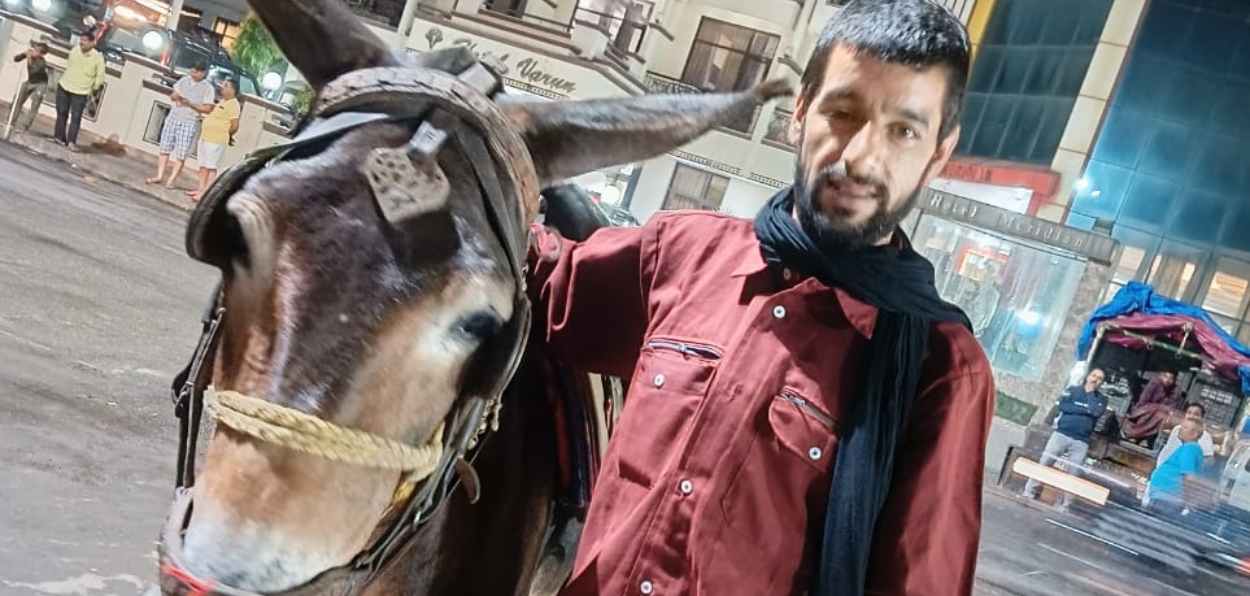
Onika Maheshwari/ Katra
Katra, the base camp of the Mata Vaishno Devi shrine pilgrimage in the Trikuta hills of Jammu and Kashmir is a symbol of Hindu-Muslim unity and its milieu sends a message of brotherhood and coexistence of people following different religions.
The Muslims of the Reasi district have been providing facilities to the Hindu pilgrims headed to the cave shrine of the Goddess for 700 years.
Mata Vaishno Devi is one of the most visited pilgrimage centers of India. It involves a 12-kilometer uphill and difficult trek from the base camp to the cave located at 5,200 feet.
The devotees can trek the distance or mount a horse, or sit in a palanquin lifted by men, and both these services are offered by Muslims. There are also pithoos, who lift the luggage and sometime small children on their back.
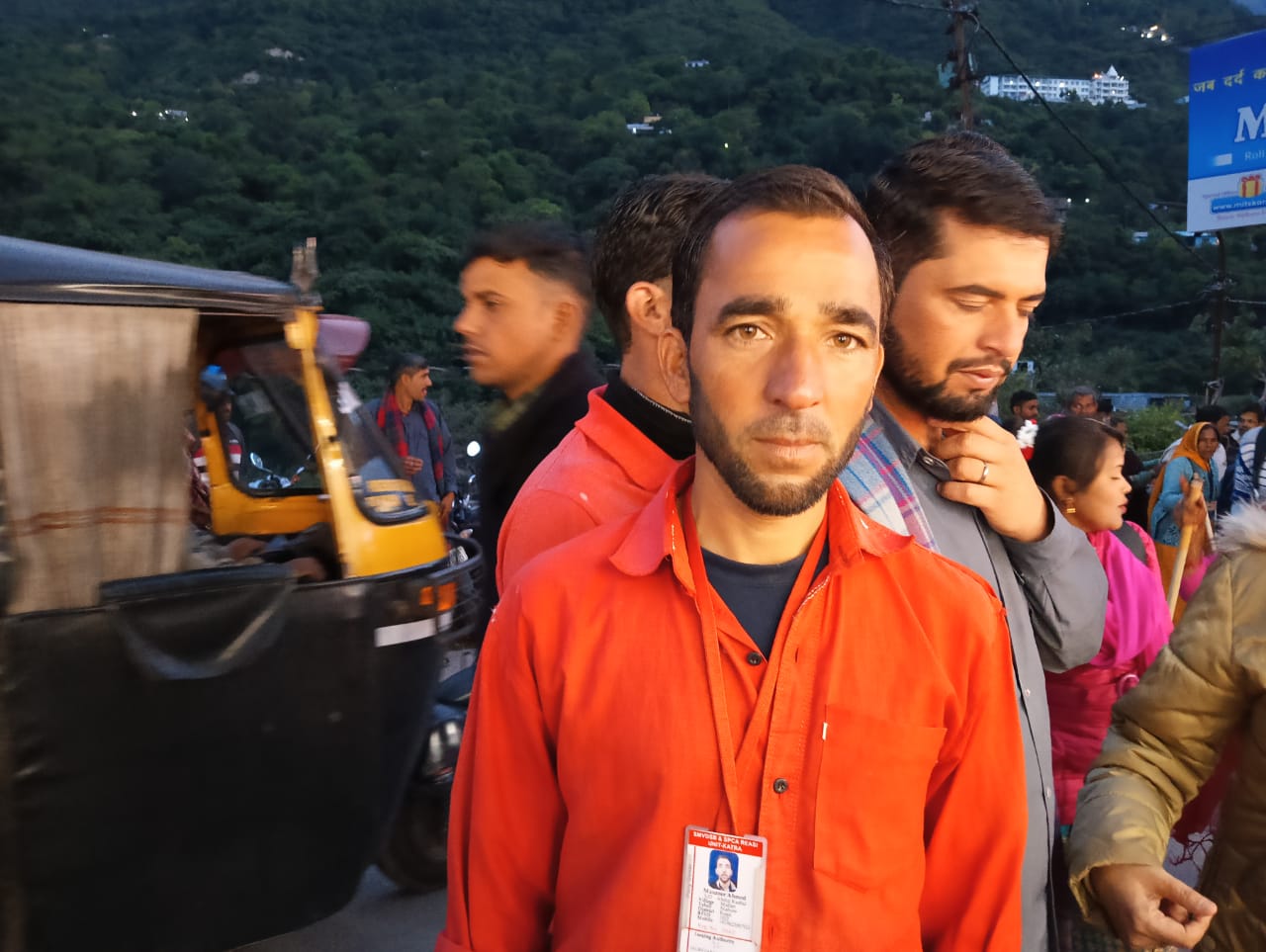
Mansoor Ahmed, Palanquin bearer, soliciting business at Katra
One can see the well-built Gujjar tribesmen and others lifting the palanquins with pilgrim drenched in sweat climbing up en route to the cave. This is their only sources of income.
It’s common for pilgrims to be greeted with 'Jai Mata Di' (Hail the Goddess) slogan as they solicit business. While climbing the hill they too chant the slogan in praise of the Goddess. A horseman or the group of people carrying a palanquin stop only three or four times while climbing hill to catch a breath.
All of them carry certificates issued by the Shri Mata Vaishno Devi Shrine Board that manages the shrine.
I spoke with many Muslims who were engaged in providing services to the pilgrims on my first pilgrimage to the shrine during Navratris.
I mounted Abdul Latif's mare 'Rozy' from Katra.
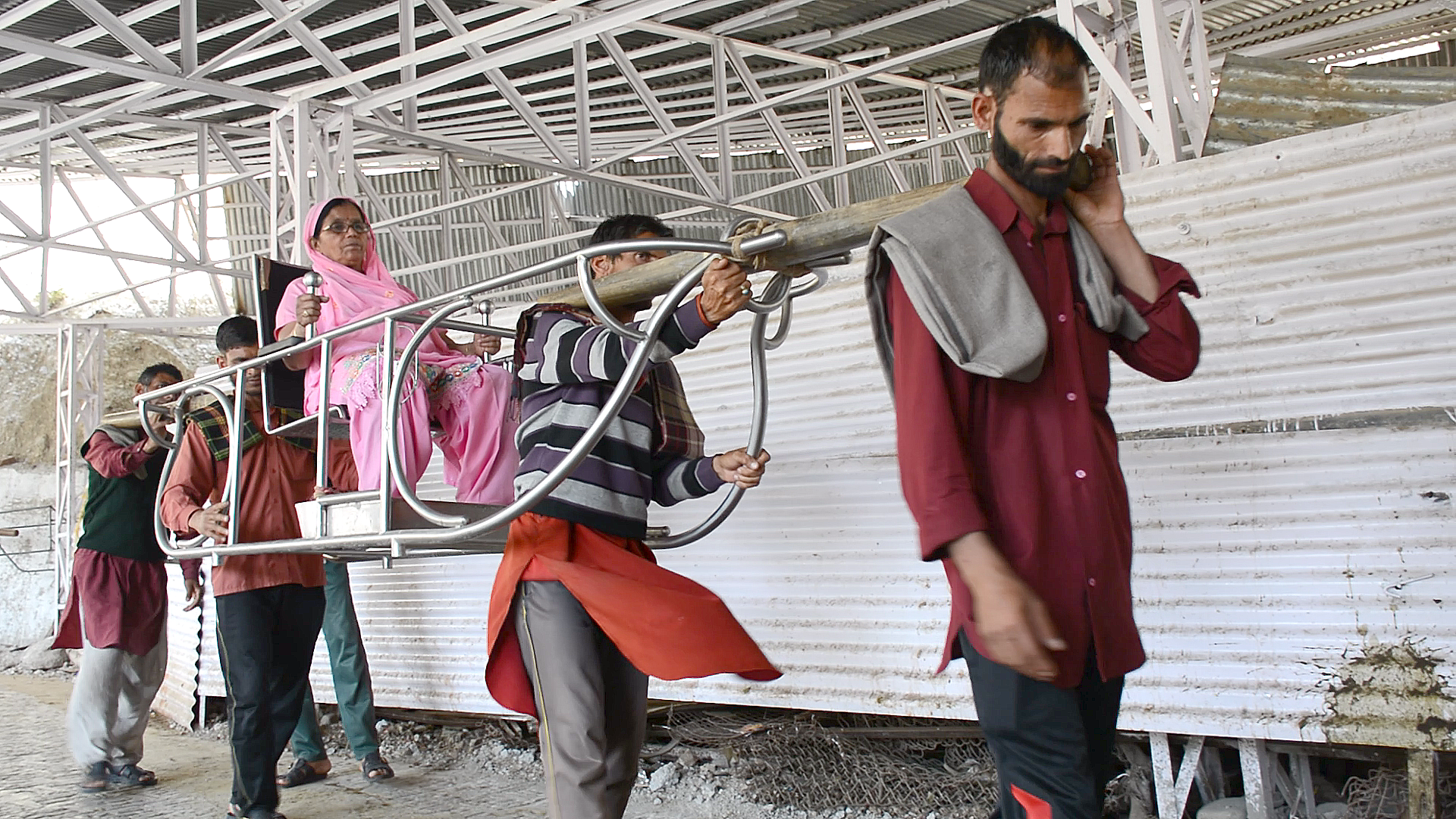
A woman pilgrim in a palanquin
Abdul Latif belongs to Reasi, the district headquarter town about 30 km away. He says all people going to the Cave have the same emotion. “There is no difference; everyone cheers in unison and chants jai Mata di.” He has been working 10 years.
Latif halted to give rozy rest while he offered namaz by the side of the trekking path. He says he earns Rs 40000 to 50,000 pm months from this work. His family lives in Reasi while he lives in a rented accommodation at katra.
Pilgrim can feel cheated since rates for each service have been fixed by the shrine board.
There are around 2500 people engaged in offering services like a horse ride, palanquin ride, carriages, and about 60 percent of them are Muslims. They mostly come from Reasi.
The shrine board and the private service providers have linked up with a private company G Max for online booking of srvices.
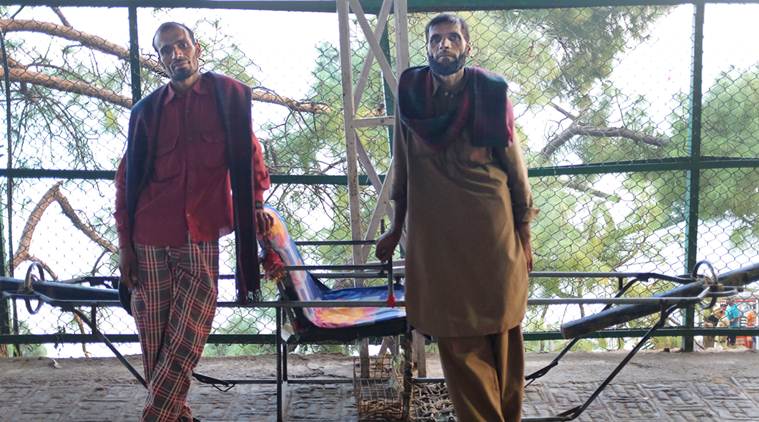
Bagghi lifters taking a break en route to the Cave shrine of Mata Vaishno Devi
Katra also has an elected body of these service providers that liaises with the shrine board on behlf of the workers.
Mostly overweight and aged pilgrims hire ponies; Pithoo is used to carry luggage and toddlers; palanquin is used by older pilgrims. The rates for their services are fixed by the Shrine Board.
The Katra market has shops selling dry fruits and restaurants offering only vegetarian and Saatvik (No onion, garlic) food. Muslims also have a good presence as they find work as headload workers.
In the just concluded Navratri, the shrine board had decorated the path to the cave with flowers marigold and, jasmine brought from about 10 countries. Flower bedecked entry gates were built to greet the pilgrims.
Last year some 90 lakh pilgrims paid their obeisance at the shrine of Mata Vaishno Devi.
The cave shrine of Mata Vaishno Devi is the most famous Siddhapeeth and most revered holy site in North India.
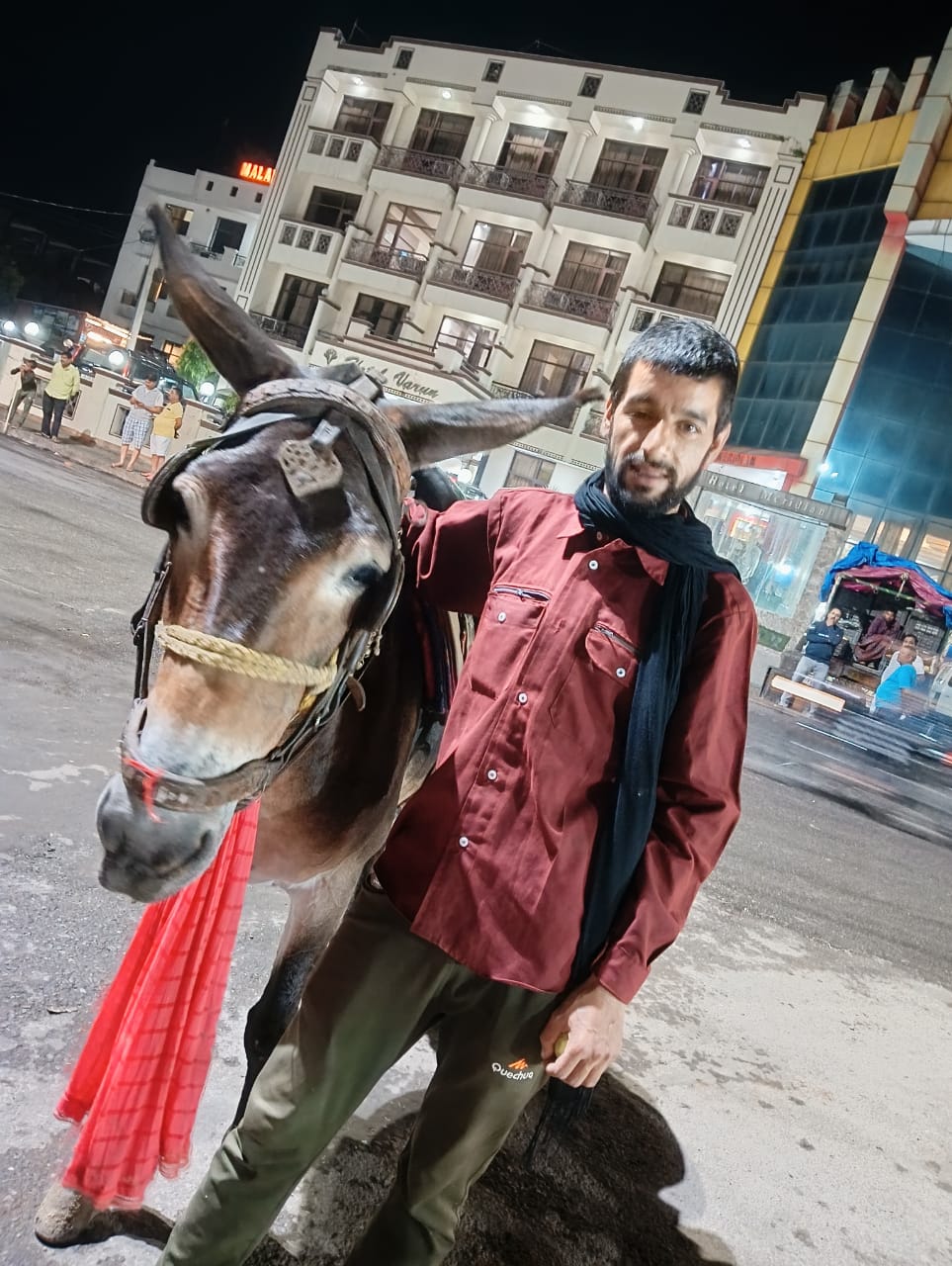
Abdul Latif with Rosy at Bhawan
Inside the natural cave, Adishakti form of Mahalakshmi, Mahakali and Mahasaraswati are in pindi form (consice) since the Treta Yuga and for the devotees, the Goddess Vaishno Devi is sitting here in her eternal formless form.
According to scriptures, this temple is also included in 108 Shakti Peethas (Seat of feminine divinity).
It is believed that the Pandvaas were the first worshipers of the goddess in the cave. Five stone figures possibly representing the Pandavas were found in a nearby mountain range, lending credence to the story of Pandavas' connection with the Vaishno Devi temple.
The story of Vaishno Devi:
A devotee of Mata Vaishnodevi, Sridhar organized a bhandara (community meal) for the villagers and Mahayogi Guru Gorakshanathji and all his followers, including Bhairavnath. He did on following the wishes of the Goddess.
On the designate day, Guru Gorakshanath arrived at Bhandara with his 300 disciples including Bhairavnath.
Goddess Vaishno surprised Bhairavnath with her powers and he challenged her. He sought the permission of Lord Shiva’s incarnation Guru Gorakhnath. The Gugu not approve of it but allowed Bhairavnath to go ahead with his plans.
Guru Gorakhnath and all his disciples enjoyed the Vaishnav food and left. However, Bhairavnath stayed on to test his powers. He tried to catch Mata Vaishnodevi and scare her.
Not interested in the fight Mata Vaishno Devi fled to the mountains to continue her Tapasya, (penance) while Bhairavnath continued to chase her.
Vaishno Devi stayed at Charan Paduka, Banganga and Ardhkuwari, and all these are stops en route to the Holy Cave. She avoided a clash but finally on reaching Bhawan – where the cave of the Goddess is located – she beheaded him.
Bhairo Nath's head fell at a distance of 1.5 km. This place has a temple of Bhaironnath.
His soul repented over this incident and asked for forgiveness from the Goddess. The goddess forgave and grated him a boon that the devotees would visit his temple to complete his pilgrimage. The pilgrims visit the temple of Bhaironath on their way back from having the darshan of Goddess.
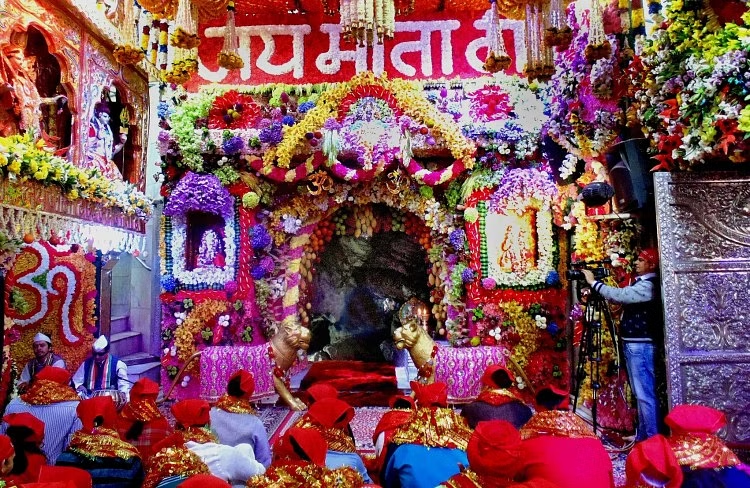
Flower bedecked entrance to the cave of Mata Vaishno devi shrine
Beliefs say that the goddess then took form of a rock and continue hr meditation.
The cave was discovered about 700 years ago by a Brahmin Pandit named Shridhar. He lived in a village named Hansali near Trikuta Mountains and was a devotee of Goddess Shakti.
One day Sridhar invited all the villagers to his residence for a meal Bhandara. However, on seeing a large number of people coming for Bhandara he was nervous on seeing an unending rush of people as he felt he didn’t have that much food to feed everyone and space to accommodate all.
At this stage, he prayed to the Goddess and she appeared as a young girlbefore him.
Suddenly there was no dearth of food and Sdridhar’s small house seemed large enough to accommodate all. After Bhandara, Sridhar wanted to thank her but the girl was nowhere to be seen.
ALSO READ: Why Farooq Abdullah objected to Nazir Josh portraying Ahad Raza in the DD serial ‘Hazaar Daastaan'
He spent many sleepless nights thinking about the young girl. One night, the goddess appeared in his dream and directed him to go towards the cave to find her abode.
He followed her instructions and discovered the cave of what is today mata vaishno Devi shtine and one of the most visited pilgrim sites in India.
